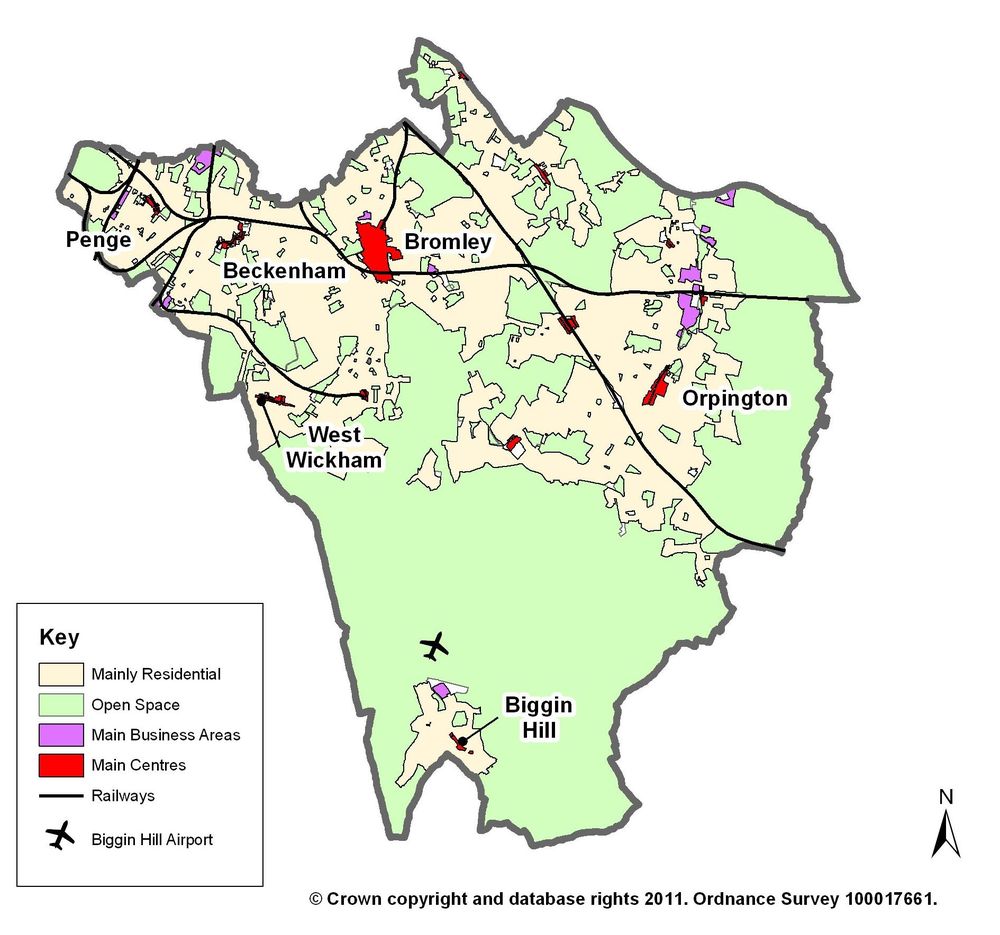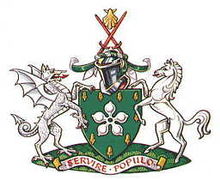


BOROUGH 19 - 60 YEARS ON
Are the villages of Farnborough Parish in London or in Kent?
Assuming you live in the village, then when asked by a non-local where you come from, you would answer ‘Farnborough’, but then probably add a qualifier to make it clear that you were not referring to the better known town of Farnborough in Hampshire, or to villages of the same name in Warwickshire or Berkshire. But what do you add?
Well of course, Farnborough has a Bromley postcode and the Borough of Bromley is today firmly in Greater London, so that is the answer. A postcode on its own should be sufficient to settle the matter, but some websites then insist on a county being added, and Kent may still be acceptable, even though erroneous
But nevertheless 'London or Kent' is not an unreasonable question. This is a modern map of the Borough of Bromley, and it can be seen that even if the rural half of the borough to the south within the 'Green Belt' is excluded, Bromley still has a lot of green space, more than any other London Borough in fact. And this is despite the significant new house building that occured after the war, particularly around Orpington.
 |
In 2025 Bromley selebrated its 60th anniversary https://www.bromley.gov.uk/bromleyatsixty
But go back over 60 years and it was not a done deal that Bromley and Farnborough would become part of Greater London.
There were fierce debates over the boundaries of the new outer London boroughs, and indeed what they would be called.
The following is taken from articles written by Pat Manning in 2005 and 2010, and are reproduced here by kind permission of the Bromley Borough Local History Society
Borough 19’, 60 years on.
April 2025 saw the 50th anniversary of the redrawing of the boundaries of London to include many areas formerly part of the surrounding Counties. ‘Borough 19’ as it was known during the planning stage became what is now the London Borough of Bromley. While the ‘London or Kent’ question still lingers on, at the time there was also intense but now largely forgotten debate about where the boundaries would be drawn and indeed what the new borough would be called.The planned reorganisation of outer London began long before it finally came about in 1965. Even before the end of WWII, Professor Patrick Abercrombie had spent over two years planning the re-organisation of London. His proposal was to divide the extended area round London into three rings dependent on residential density. The Inner ‘Urban Ring’ included Penge. Beckenharn was in the ‘Suburban Ring’ within 12 miles of Charing Cross and it was hoped to limit building in the ‘Green Belt Ring’ to secure a country belt round London.
Penge firmly rejected amalgamation with Beckenham in 1958 or embodiment in the LCC because neither would secure better local government for Penge, and it continued to hold this view at the Royal Commission in July 1959. It claimed that its past record as an Urban District Council (UDC) showed Penge perfectly capable of discharging its functions although it had no hospital, fire service or independent refuse collection.
Beckenham had been hoping for County Borough status. The case was presented by Alderman Parkin at Agriculture House, Knightsbridge in July 1959 with the backing of the Mayor, CIr Robbins, the Town Clerk, the Borough Engineer and Alderman Atkins. He argued that whether in partnership with Penge or Bromley, Beckenham with its population of 75,000 was perfectly capable of running its own affairs. Beckenham had been steadily shorn of its major functions since the war by transfer to the cumbersome machinery of the County (Kent) and it wanted to return to a single tier of administration.
Bromley proposed a different case altogether, suggesting a Joint Board’ of Bromley, Penge, Beckenham, Chisleburst, Sidcup and Orpington.
Orpington’s Eric Lubbock introduced a further variation: Orpington, Chislehurst and Sidcup should be a separate third borough. He instanced the combined education service of Orpington, Chislehurst and Sidcup, and Orpington’s then rapid development that would result in a rninimum of 200,000 people by the early 1970s..
By February 1963 it was clear that four and a half councils would be united into Borough 19. With a government majority of 50, the final decision on the constituent councils for B19 and the neighbouring B18 was taken, to the intense disappointment of Chislehurst and Sidcup which would now be separated: South-of the A20, Chislehurst was in B19 with Brornley, Beckenham, Penge and Orpington, but Sidcup was in B18 with Bexley. Erith and Crayford. Chislehurst’s Dame Patricia Hornsby-Smith said that Sidcup had no affinity with the rest of B18 and should not be separated from B19.
It all made no difference, because Sir Keith Joseph resisted all attempted amendments. He stated that there were only two natural centres Bromley and Bexley. and that the various authorities should be grouped round them.
What's in a Name?
The next challenge was to find a name for Borough 19, which would be the largest of all the London boroughs with seventy new council members. The Mayors of Bromley and Beckenham tried hard to clear the air because the joint advisory committee had recommended the name ‘Brornley’ for the new Borough.However this was firmly rejected by 17 votes to 10 when Beckenham Council debated the subject. Councillor Read declared it had been chosen ‘for Bromley’s self-glorification’. Councillor Gordon-Smith had three suggestions, Kentgate, (also favoured by Orpington). Ravensbourne, and Churchill. Alderman Duncan favoured Ravensbourne saying that the people of Beckenham would never support the name Bromley, but others said that the river was little more than a ditch these days, so hardly suitable for the new borough’s name. It was suggested that Bromley was only waiting for the opportunity to ‘spend Beckenham’s money’.
The Kentish Times suggested that borough 19 be called West Kent and borough 18 be named North Kent 'to retain our association with the county'. However Alderman Parkin thought that Bromley was a good choice because Bromley was the oldest and best-known town in the area with a centuries-old market and was situated in the centre of the new borough. He also recognised that ‘if we did not decide for ourselves, Whitehall would decide for us’.
Last minute pleas in 1964 from three of the five constituent authorities for the new borough to be called Ravensbourne were rejected by the Privy Council, and the Queen approved the name ‘Bromley’.
Moving Forward
it was a bitter pill for the areas of Beckenham and West Wickham, Penge, Orpington and Petts Wood, Chislehurst and Bromley when they were forced to relinquish their individuality and combine into a single London Borough in 1965.
 |
Of course, ultimately Borough 19 became Bromley and new Arms and motto were devised. A cinquefoil in the centre of the shield was used to represent the unification of the five councils. The scallop shell was for the Diocese of Rochester, the numerous acorns were for the Kentish oaks and the silver horse was the horse of Kent. The remaining symbols of dragon and crossed swords were symbolic of London. |
In this way, the new borough was set in a background of old and new without causing offence to any of the preceding councils. All the old mottos were replaced with the new Servire Populo (Serving the People). It is interesting that the old Beckenham mace was retained with the new Bromley arms and that the Beckenham Mayor’s chain of office is still occasionally worn.
One man who lasted throughout Beckenham’s life as a Borough, Alderman Henry Parkin, continued to serve the new Bromley Borough for a further 20 years. One of the 10 new Aldermen elected at the first full meeting of the council, he was also the chairman in charge until he was elected the first Mayor of the London Borough of Bromley 11 months later. Since no civic building existed capable of housing all the departments, the best use had to be made of the offices of the former authorities. The Beckenham Town Hall became the home of the Borough Engineer, Surveyor and Planning and Penge Town Hall accommodated the Borough Architect.Thomas Webster Fagg from the Chislehurst and Sidcup UDC became the Town Clerk with his offices at the Bromley Town Hall, the Medical Officer went to the Walnuts at Orpington and education, formerly managed by Kent, was housed at Sunnymead, Chislehurst.
We were fortunate that a gifted accountant, Thomas William (Tom) Sowerby, had come to be Beckenham’s treasurer in 1961 in readiness for the change. An ex-squadron leader, with over 25 years’ experience in local government, most recently for Worcestershire County Council, he was used to dealing with thousands rather than the hundreds of pounds in Beckenham’s accounts. He valued the sterling qualities of Beckenham’s Councillors and stayed in the new Borough until 1977. He had spent 43 years in local government and had come to suspect that Whitehall was seeking to infiltrate it. He warned that the Government would soon be telling the local authorities exactly how to spend the budgets allowed.
On 15 April 1964 at the inaugural lunch at the Town Hall Bromley, the Charter Mayor, Sir Cuthbert Ackroyd, presiding, included in his speech: “We stand today in the presence of history and I emphasise that the five authorities concerned in the coming amalgamation will still remain local communities with their own local loyalties.”
Looking back over 40 years we can see that this has not always been possible, but it is still worth fighting for.
Pat Manning
THE LOCAL AREA
But What If?
The question 'What if?' can take us to interesting places. What if the Local Government Act (LGA) had failed to gain Royal Assent over 50 years ago?The following, abridged from an article written by Laurence Cawley, in 2013 is from the BBC news website archive.
The Local Government Act (LGA) was the act which officially recognised Greater London and redrew the boundaries between London and the counties which surround it. In one fell legislative swoop, long-standing parts of Essex, Kent, Surrey and Middlesex were suddenly sucked into the new administrative area of Greater London. Without the passing of this act a number of places (including Orpington and Bromley) would still be outside London.
The ideas behind the changes were to meet the challenges of a growing London. Creating a Greater London offered economies of scale, room to grow and planning on a greater canvas. But the reverberations of the LGA are felt even now. Ask somebody from Romford, for example, where they live and many will say they live in Essex, despite Romford being firmly in the London Borough of Havering. It is a similar story in Bromley. many residents say they still feel they are part of Kent, rather than London. And ask someone from Harrow and they may say Middlesex, even though that county no longer exists at all.